Exploring the Anatomy and Function of Tyrannosaurus Teeth
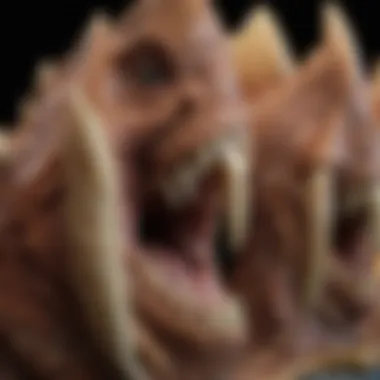

Intro
The study of dinosaur teeth, particularly those of the Tyrannosaurus rex, provides crucial insights into the life and environment of one of the most formidable predators of the Late Cretaceous period. Unlike many other creatures, the teeth of Tyrannosaurus are not only fascinating in their anatomy but also tell a story about their evolution and predatory habits. This article aims to explore these aspects in detail while also addressing broader implications for paleontology.
Teeth serve multiple functions, primarily for feeding, which directly links to a species' survival. The shape, size, and wear of Tyrannosaurus teeth can reveal much about its diet and hunting methods. No element in its anatomy is isolated; rather, it all contributes to a clear picture of how it operated within its ecosystem. Through fossil records, we gain access to these unique characteristics, enhancing our understanding of its place in the food chain.
Understanding the intricacies of their teeth helps decode feeding strategies and can suggest adaptability to changing environments. The evolution of these teeth reflects not just the creature’s biology but also hints at the ecological pressures of its time. By integrating anatomical analysis with fossil records, we aim to provide a comprehensive view of the Tyrannosaurus and its remarkable adaptations.
Foreword to Tyrannosaurus Teeth
The study of Tyrannosaurus teeth plays a crucial role in understanding not only the anatomy of this iconic dinosaur but also its ecological significance during the Late Cretaceous. This introduction sets the stage for a comprehensive exploration of the unique dental features that defined the predatory prowess of Tyrannosaurus rex.
Overview of Tyrannosaurus rex
Tyrannosaurus rex, one of the largest land predators, roamed North America around 68 to 66 million years ago. Recognized for its powerful build and formidable size, the T. rex was equipped with a highly specialized dentition. The teeth of this dinosaur were not merely tools for eating; they played an essential role in its survival strategy.
The structure of its teeth allowed for efficient prey capture and processing, vital for a predator of such magnitude. Their large, serrated crowns facilitated the tearing of flesh, demonstrating an evolutionary adaptation to a carnivorous lifestyle. Understanding the physical characteristics of these teeth provides key insights into the feeding habits and daily life of T. rex.
Importance of Teeth in Paleontology
Teeth are among the most significant indicators of dietary preferences and behavioral patterns in extinct species. Fossilized teeth often provide more information than bones, as they are more durable and frequently preserved in the fossil record. In paleontology, the morphology of teeth can reveal a wealth of information regarding the animal's ecology, feeding mechanisms, and phylogenetic relationships with other species.
For the Tyrannosaurus rex, the study of dental fossils is particularly significant. It helps reconstruct feeding strategies and interactions with its environment. Paleontologists utilize dental wear patterns to infer the types of prey T. rex hunted, as well as its role within the ecosystem. By analyzing these factors, researchers can draw conclusions about the overall health and behavior patterns of this fascinating theropod.
"The teeth of Tyrannosaurus rex provide a direct link to understanding its role as a top predator and landscape modifier in its environment."
Through careful examination of Tyrannosaurus teeth, scientists continue to unravel the complexities surrounding its biology and ecology, shedding light on the life and times of these ancient giants.
Anatomical Features of Tyrannosaurus Teeth
Understanding the anatomical features of Tyrannosaurus teeth is crucial for grasping how this formidable predator thrived during the Late Cretaceous period. Each tooth's specific characteristics complement its roles in feeding and predation. The detailed anatomy of these teeth reveals insights into the animal’s behavior, ecological interactions, and evolutionary adaptations.
Types of Teeth: Differentiation and Structure
Tyrannosaurus rex had a varied dental arsenal. Its teeth could be categorized mainly into different types based on their structure and function. The most notable types include:
- Maxillary teeth: These are large and robust, adapted for shearing. Their serrated edges enhance cutting efficiency, enabling the T. rex to slice through flesh and bone.
- Anterior teeth: These are forward-facing and tend to be conical. Their primary purpose likely includes grabbing and holding onto prey. Their pointed shape supports penetration into the flesh of animals.
Additionally, the structure of the teeth plays a role in overall predation strategy. The differentiation allows the T. rex to handle various prey items effectively, which varied from dinosaurs to other smaller creatures.
Dimensions and Shape: Adaptations for Feeding
The dimensions and shapes of Tyrannosaurus teeth reflect specific adaptations for its feeding habits. The large size of individual teeth can be attributed to its diet which included sizeable herbivorous dinosaurs. Key features include:
- Width and length: The teeth of T. rex could measure up to 30 centimeters long, allowing for significant force generation during bites.
- Curvature: Most teeth were slightly curved, an adaptation that may have allowed for a better grip on struggling prey.
Such features demonstrate how dental form relates to function. The larger, more powerful teeth are instrumental in overcoming the tough hides of large prey. This adaptation highlights the evolutionary pressures that shaped the species over generations.
Enamel Composition and Strength
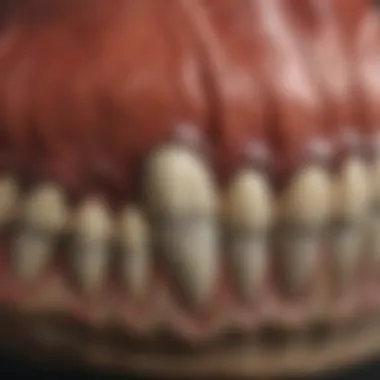
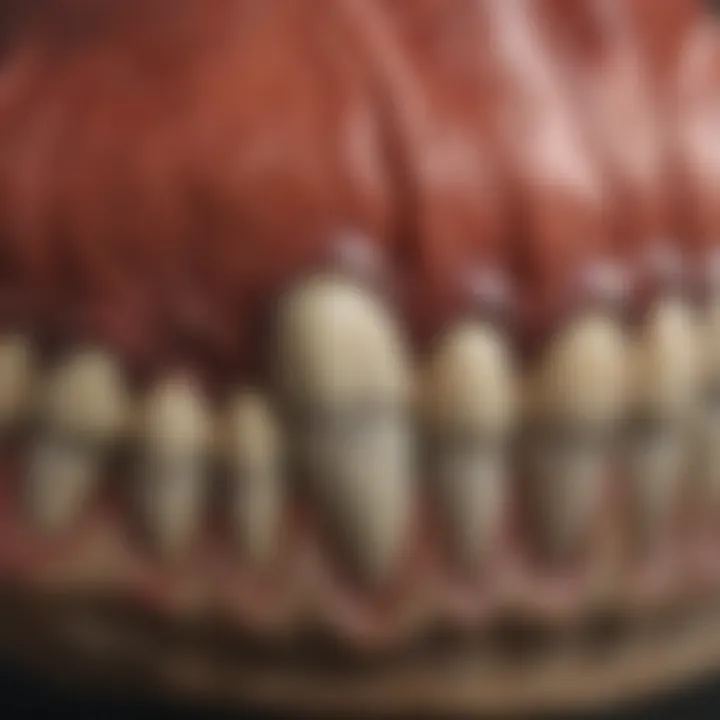
The enamel of Tyrannosaurus teeth shows remarkable properties that contributed to their durability and effectiveness as predatory tools. Enamel composes a significant part of the tooth structure, influencing its performance in several ways:
- Thickness: Thick enamel layers provide resistance to wear and tear. This is essential given the T. rex's likely high feeding frequency and the physical demands of biting prey.
- Mineralization: Studies indicate a unique composition that results in higher toughness compared to other theropods. This characteristic secures the teeth against chipping and cracking under stress.
In summary, the enamel composition and strength underscore the evolutionary advantage of T. rex's teeth, allowing it to maintain effectiveness as a predator. This understanding of enamel reinforces insights into dietary habits and ecological roles within its habitat.
"The teeth of Tyrannosaurus rex serve not only as tools for survival but as vital indicators of its ecological niche and evolutionary adaptations."
Overall, dissecting the anatomical features of Tyrannosaurus teeth reveals their critical roles in the life of one of history's towering predators. From structure to material properties, each aspect combines to provide a clearer picture of how T. rex maintained its status as an apex predator.
Evolutionary Aspects of Tyrannosaurus Teeth
Understanding the evolutionary aspects of Tyrannosaurus teeth is crucial for contextualizing their anatomical features, functionality, and ecological roles. This section delves into the phylogenetic relationships that delineate the lineage of Tyrannosaurus and how these connections influence the dental patterns observed in the fossil record. The analysis of evolutionary developments sheds light on adaptations that aided this dinosaur in hunting and consuming prey effectively. This insight is not only valuable for paleontologists but also for hobbyists and collectors interested in the broader implications of these findings in the context of prehistoric biodiversity.
Phylogenetic Relationships and Dental Patterns
The phylogenetic relationships between Tyrannosaurus rex and other theropods provide a framework for understanding its dental patterns. Tyrannosaurus is part of the clade Tyrannosauridae, a family characterized by their robust bodies and strong skulls. An investigation into the dental characteristics of related species reveals a trend towards larger, more robust teeth. These adaptations appear tailored for a carnivorous diet, allowing for efficient predation on large prey.
In addition, examining the evolutionary timeline helps clarify how dental morphology has been shaped by environmental pressures. For example, the shift in tooth structure from serrated edges to the more robust design seen in Tyrannosaurus reflects changes in available prey types and hunting strategies. This transition illustrates a significant aspect of how evolutionary pressures refine feeding adaptations.
Comparison with Other Theropods
When contrasting Tyrannosaurus teeth with those of other theropods, notable differences arise. Smaller theropods, such as Velociraptor, possess different dentition, characterized by narrower, more pointed teeth. These features suggest a variation in feeding habits, possibly favoring smaller prey or scavenging behavior.
In contrast, larger theropods like Spinosaurus had elongated conical teeth suited for catching fish. This comparison underscores the diversity in tooth morphology adapted to specific ecological niches and predation techniques.
Tyrannosaurus teeth stand out primarily due to their sheer size and strength, designed to handle the substantial forces involved in biting and crushing bone. The unique features of their teeth reflect an evolutionary arms race in survival strategies among theropods, marking their distinct role in the ecosystem of the Late Cretaceous.
"The study of Tyrannosaurus teeth not only reveals their predatory efficiency but also enhances our understanding of evolutionary biology and adaptation within prehistoric ecosystems."
A detailed examination of these evolutionary aspects ultimately underscores the complexity of predator-prey dynamics and the role of anatomical adaptations in the survival of this iconic dinosaur.
Functional Role of Teeth in Predation
The functionality of teeth in the context of predation cannot be overstated. In the case of the Tyrannosaurus rex, the teeth served multiple roles that were critical to its success as a dominant predator during the Late Cretaceous period. Their structural features and arrangement were finely adapted for capturing, holding, and consuming prey, which will be discussed in detail in the following subsections.
Mechanics of Bite Force
The mechanics behind the bite force of Tyrannosaurus teeth is a topic of significant interest. Research indicates that T. rex had one of the strongest bite forces of any terrestrial animal, with estimates suggesting it could exert around 12,800 pounds of pressure. This immense force was essential for penetrating the tough hides of large prey such as hadrosaurs and ceratopsians.
The configuration of their teeth contributed to this power. The teeth were large, conical, and serrated, allowing them to slice through flesh and bone effectively. The lower jaw was also designed to facilitate a strong bite, which helped maximize the effectiveness of each feeding event.
An important aspect of the bite mechanics relates to the jaw muscle structure. The temporalis muscle was remarkably developed, providing considerable leverage and strength. The force generated during biting gave T. rex a significant advantage over its competition in the harsh environments it inhabited.
Prey Processing and Dental Wear Analysis
Tyrannosaurus teeth played a pivotal role in the processing of prey. Once the powerful bite grasped its victim, the serrated edges of the teeth sliced through flesh, assisting in the immediate consumption of meat. The design of the teeth allowed them to endure wear caused by this frequent and aggressive processing.
Dental wear patterns observed in fossil specimens reveal a great deal about the feeding habits of T. rex. Certain teeth exhibit wear consistent with forces experienced during prey processing, such as deep scratches or wear facets indicative of significant use. This type of analysis can reveal a lot about what types of animals T. rex was preying upon and how varied their diets might have been.
"The teeth of Tyrannosaurus serve not only as tools for predation but also as fascinating records of their life history and ecological interactions."
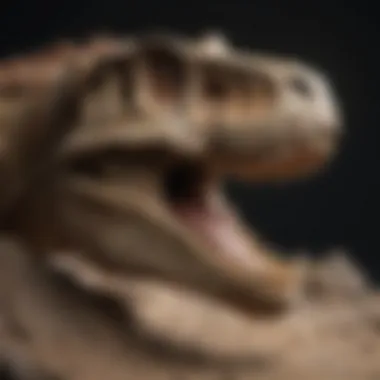
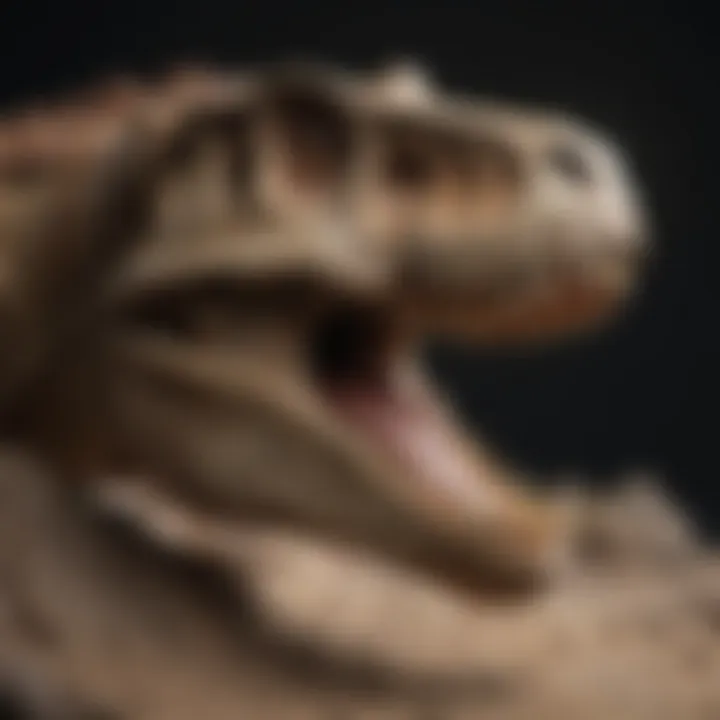
Overall, the functional aspects of T. rex teeth highlight the complex interplay between anatomical structure and predatory behavior. Understanding these roles provides insight into how Tyrannosaurus effectively managed to thrive as an apex predator in its time.
Paleontological Evidence: Fossil Findings
The study of fossil evidence plays a crucial role in understanding the anatomy and behavior of extinct species like the Tyrannosaurus rex. Fossils provide the only tangible record of these ancient creatures, allowing paleontologists to piece together their evolutionary history and ecological roles. In particular, findings related to the teeth of Tyrannosaurus are illuminating. They highlight not just the predatory adaptations that the species developed but also reveal insights into their environment and dietary habits. By examining specific fossil sites and analyzing dental remains, researchers can make informed conclusions about the life of these iconic predators.
Notable Fossil Sites and Findings
Several fossil sites have yielded important findings regarding Tyrannosaurus teeth. Some of the most significant include:
- Hell Creek Formation: Located in Montana, this site is rich in Late Cretaceous fossils. Teeth specimens found here have helped scientists understand the morphology and wear patterns typical of Tyrannosaurus.
- Lance Formation: Situated in Wyoming, this formation has produced various dinosaur fossils, including well-preserved teeth. The dental evidence from this area supports theories about diet and predatory behavior.
- Morrison Formation: Although this site is primarily known for other dinosaurs, it has provided comparative insights into the dental structures of similar theropods.
These sites not only prove to be rich in Tyrannosaurus fossils but also provide a broader context for understanding the ecological dynamics of their time. The detail in the fossil record helps differentiate species within theropods and enhances our appreciation for their adaptations.
Analysis of Dental Remains
The analysis of dental remains is essential for reconstructing the feeding habits and lifestyles of Tyrannosaurus. Dental wear patterns can indicate the types of prey consumed. Healthy teeth display specific patterns of wear based on diet, and scientists are keen to study these traits. Key points of analysis include:
- Wear Patterns: The grooves and scratches on teeth can reveal how they interacted with different types of food, such as bone or soft tissue.
- Dental Pathologies: Evidence of diseases or injuries can also provide insights into the behavior of Tyrannosaurus. For example, healed fractures may indicate encounters with prey or rival predators.
- Comparative Analysis: By comparing Tyrannosaurus teeth with those of other theropods, paleontologists can understand how different species evolved unique adaptations for survival.
In summary, the fossil evidence concerning Tyrannosaurus teeth contributes significantly to our understanding of this apex predator. These studies not only broaden our knowledge of dinosaur biology but also allow for a deeper exploration of evolutionary patterns in prehistoric ecosystems.
Case Studies: Examining Dental Pathologies
Understanding dental pathologies in Tyrannosaurus fossils is crucial. These studies offer insights into various injuries and diseases that affected these giant predators. By examining any lesions or wear on teeth, researchers can infer the general health and lifestyle of these creatures. This section provides a focused analysis of specific pathologies discovered in dental remains, as well as their implications for interpreting paleobiology and evolutionary patterns.
Identifying Injuries and Diseases in Fossils
The process of identifying injuries in Tyrannosaurus teeth involves detailed examination of wear patterns. Fossils can exhibit signs of dental disease, such as abscesses or abnormal wear. These findings are significant as they can highlight events that shaped the lives of these predators.
- Dental Abscesses: These occur when bacteria infect the tooth and form pus. In fossils, this may appear as irregular growth or distortion in the tooth structure.
- Enamel Chipping: This often results from biting into hard materials or prey. It reveals the feeding habits and challenges faced during hunting or eating.
- Pathological Growths: Tumors or other abnormal growths can be identified on dental remains. These are rare but informative regarding the health conditions of individuals.
The observations of such injuries give researchers a clearer picture of the challenges Tyrannosaurus faced in its lifetime, providing valuable data for paleontological studies.
Implications for Behavior and Life History
The analysis of dental pathologies has profound implications for understanding the behavior and life history of Tyrannosaurus. The presence of injuries not only suggests certain predatory behaviors but also allows for inferences about survival strategies.
- Social Dynamics: Injuries on teeth could indicate social interactions, such as fights with rivals or potential competition for mates.
- Health and Longevity: The type and severity of dental diseases may reflect the overall health of individual specimens. Healthier specimens might show less wear or fewer injuries compared to older ones.
- Behavioral Adaptation: The way Tyrannosaurus adapted its feeding techniques could have been influenced by dental health. Observing wear patterns may help predict shifts in prey selection or hunting strategies over time.
In sum, analyzing dental pathologies enriches our understanding of Tyrannosaurus's life, including how its biology interacted with its environment.
Cultural Implications of Tyrannosaurus Teeth
Understanding the cultural implications of Tyrannosaurus teeth reveals much about how these ancient structures affect contemporary thought and expression. The fascination with dinosaurs, particularly the Tyrannosaurus rex, extends beyond fossil records. It touches on areas like art, media, and public education. This cultural significance can shape perceptions of prehistoric life and the importance of paleontology.
Representation in Popular Media
Tyrannosaurus rex achieves iconic status in popular media. Films, documentaries, and books often depict this dinosaur as the apex predator of its time. Notable examples include Jurassic Park, which showcases its powerful bite and terrifying presence. These representations contribute considerably to our understanding and imagination of T. rex.
The way in which these media present the teeth of the T. rex influences public perception directly. Often, the portrayal emphasizes the ferocity and efficiency of its design. Such depictions are not fully accurate, sometimes overshadowing the scientific realities of how these teeth functioned in the animal's life. For many, the famous image of T. rex is primarily tied to its teeth, framing it as a formidable hunter of the Late Cretaceous period, which can lead to misconceptions about its actual behavior and ecology.
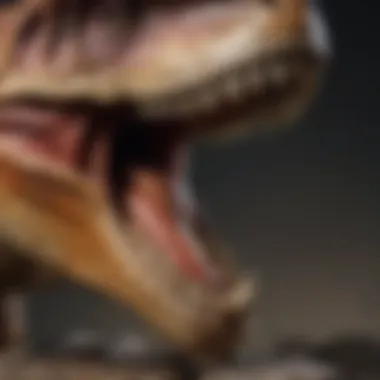
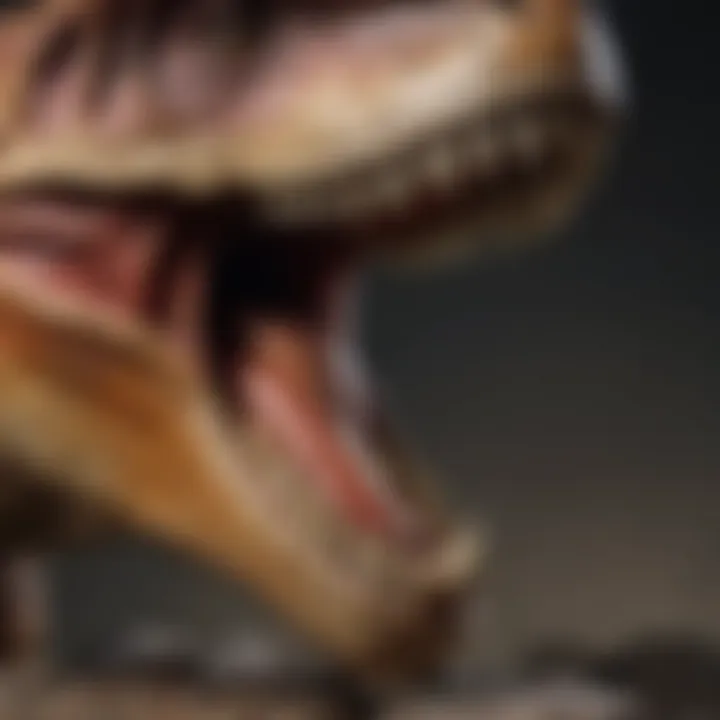
Impact on Fossil Collecting and Valuation
The allure surrounding T. rex teeth also drives fossil collecting. Many hobbyists and collectors recognize the value of authentic specimens. A single tooth can fetch a high price, reflecting its cultural significance as well as its paleontological importance. Collectors often seek these teeth for personal collections, educational purposes, or investment opportunities.
The market for dinosaur fossils, particularly for T. rex, fluctuates based on cultural interest and scientific advancements. Here are some factors affecting its valuation:
- Rarity of Specimens: Authentic T. rex teeth are rare, which increases their market demand.
- Condition: Well-preserved teeth often command higher prices than those with significant wear or damage.
- Provenance: The history of the specimen can influence its value. Teeth with detailed documentation are often more sought after.
"Tyrannosaurus rex has become more than a dinosaur; it is an enduring symbol of science, imagination, and cultural intrigue."
Future Research Directions
The field of paleontology is constantly evolving. Future research on Tyrannosaurus teeth holds significant potential to deepen our understanding of dinosaur biology and their environments. Continued investigation into their morphological features, wear patterns, and dental pathologies can reveal information about their behavior and ecology. Studies focusing on technological advancements and interdisciplinary approaches will be particularly beneficial, opening new avenues for exploration and understanding.
Technological Advancements in Paleontology
Recent technological advancements provide paleontologists with tools that enhance their ability to study fossils. For example, high-resolution imaging methods such as micro-CT scanning allow for detailed examinations of tooth structure without damaging the specimen. This technology reveals internal features that were previously inaccessible. It facilitates the analysis of the microstructural elements of enamel and dentin, providing insight into growth patterns and potential health issues.
Benefits of Technological Integration:
- Enhanced Visualization: Achieving a clearer understanding of tooth morphology.
- Non-Destructive Analysis: Preserving valuable specimens while conducting detailed studies.
- Data Collection: Gathering vast amounts of data that can be analyzed with software for more accurate results.
These methods can help reconstruct feeding habits and dietary preferences in greater detail, potentially revealing changes in ecological niches over time.
Interdisciplinary Approaches to Fossil Study
Interdisciplinary collaboration is essential for enriching the study of Tyrannosaurus teeth. It combines knowledge from various fields such as geology, biology, chemistry and even informatics. By employing a broad range of methodologies, researchers can develop more comprehensive theories about the life of dinosaurs.
Key Aspects of Interdisciplinary Research:
- Geochemistry: Analyzing stable isotopes in tooth enamel to understand dietary habits and environmental shifts.
- Biomechanics: Using computer simulations to model bite forces and feeding strategies, offering insights into predatory behavior.
- Historical Ecology: Studying the relationship between tooth characteristics and the ecosystem in which Tyrannosaurus lived.
Collaborative efforts increase the scope of research and may yield more robust conclusions regarding the evolutionary adaptations of these iconic predators.
"Through advanced methods and collaboration, we can piece together the complex life history of the Tyrannosaurus, illuminating its role in the prehistoric ecosystem."
The End: Reflecting on Tyrannosaurus Teeth
The examination of Tyrannosaurus teeth has profound implications for paleontology and our understanding of dinosaur biology. This exploration not only highlights the anatomical features and adaptations of these formidable teeth but also underscores their role in the predatory lifestyle of one of history's most iconic creatures. The structural analysis of teeth provides insight into the feeding habits, behavior, and ecological significance of Tyrannosaurus rex. Moreover, it illuminates evolutionary processes that shaped these adaptations over millions of years.
Summary of Findings
Throughout this study, several key findings emerge regarding the teeth of Tyrannosaurus rex. The anatomical structure reveals a mixture of sharp, serrated edges designed for slicing through flesh. The size and proportion of the teeth indicate an adaptation for powerful bites, essential for a predator of its size. Understanding the enamel composition and the dental wear patterns offers further insights into its diet and prey selection. Additionally, noteworthy fossil findings enrich our understanding of how these teeth functioned in a multifaceted ecosystem during the Late Cretaceous period.
- Key anatomical features:
- Fossil evidence highlights:
- Sharpness and serration suitable for predation.
- Strong enamel composition for durability.
- Dental remains linking to prey remains.
- Pathological conditions indicating health issues influenced by hunting strategies.
Hence, the summary showcases how teeth serve as vital indicators of lifestyle and adaptation in extinct species.
Significance for the Understanding of Dinosaur Biology
The study of Tyrannosaurus teeth allows scientists to draw conclusions about the overall biology of dinosaurs. By interpreting dental features, researchers can infer aspects of behavior, ecology, and evolutionary trends. In this regard, Tyrannosaurus teeth become symbolic pieces of a grand puzzle in understanding dinosaur life.
In essence, these findings shape our comprehension of predation and survival strategies in ancient ecosystems. They also emphasize the evolutionary pressures that led to the varied dental features observed across theropods. By comparing the dental characteristics of Tyrannosaurus with other theropods, scientists can explore lineage development, dietary shifts, and ecological niches occupied by these creatures.



